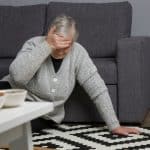Falls pose a significant health risk to seniors, and can sometimes result in injury or even death. Falling is more common among older adults than many people realize. A study reported by the CDC and conducted in 2018 concluded that 27.5 percent of seniors over the age of 65 reported falling over the prior year. This means that over a quarter of senior citizens have experienced a fall, and adds up to 35.6 million falls in a year.
This study also found that 10.2 percent of adults who had fallen experienced a fall-related injury. This adds up to 8.4 million injuries in the year. These injuries can be very serious and in rare cases result in death. Some of the most common injuries related to falling include broken bones, head trauma, and injuries to the spine and pelvis.
Why is falling so dangerous?
Older adults are physically more fragile than their younger counterparts, which means that falling can be incredibly dangerous. Seniors are more likely to suffer from osteoporosis or other bone issues, which means that a fall is more likely to result in a broken bone. Damage to the hips and pelvis as the result of a fall is very common. Muscle damage, such as sprains, strains, and bruising, can also be very dangerous for seniors. Many falls result in serious complications that require surgery. Seniors take much longer to recover from surgery than younger people, and are also more likely to experience complications as a result of medical procedures or medications. Because of these increased risk factors, it’s very important for seniors to take steps to prevent themselves from falling.
How can seniors prevent falls?
There are a number of different reasons why seniors are more likely to experience a dangerous fall. Seniors often lose their eyesight, which makes it more difficult for them to avoid obstacles. It’s also very common for seniors to have impaired neurological function or muscle control, which increases the chances of tripping and falling.
There are many things that seniors and their loved ones can do to prevent falls. The easiest way to do this is by keeping your home clean and safe. Remove any clutter from the floors, make sure hallways are well-lit, and use non-slip floor material. Installing hand rails can also make the space safer and more comfortable for older adults. Wearing shoes at home and avoiding baggy pants can also make seniors less likely to trip and fall.
Fall detection devices, like smart watches and pendants, can also be lifesavers in the event that you do fall. These devices use devices like accelerometers to determine if you’ve fallen and contact the appropriate emergency response teams. The increased response time can make all the difference when it comes to saving someone’s life.
Falling is more common among seniors than you might think. Taking steps to prevent falls is key to avoiding serious injuries like bone fractures and head trauma.



